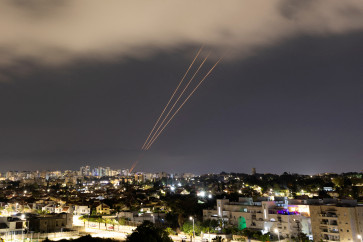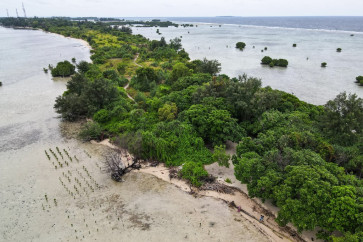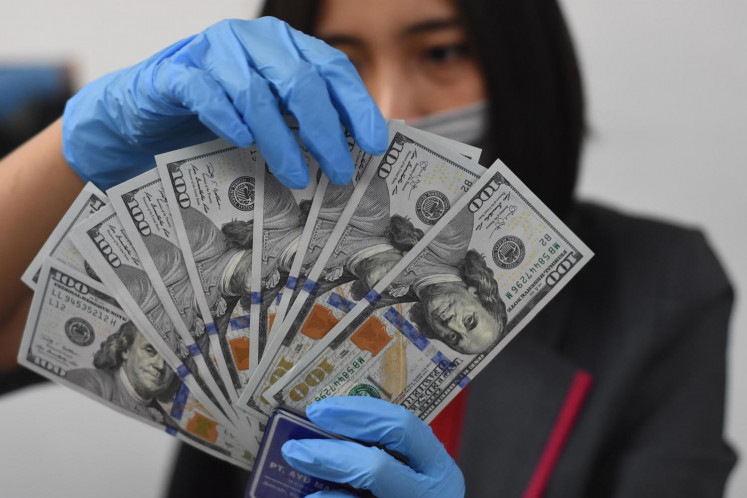Young people reading cultural archives
New interpretation: Muhammad Fauzi and Syaiful Anwarâs work is among 11 winners of grants Hibah Karya! (Project Grant!) awarded by The Archipelago Cultural Archives Network
Change Size
 New interpretation: Muhammad Fauzi and Syaiful Anwarâs work is among 11 winners of grants Hibah Karya! (Project Grant!) awarded by The Archipelago Cultural Archives Network. (Courtesy of Sidang Hans Bague)" border="0" height="280" width="498">New interpretation: Muhammad Fauzi and Syaiful Anwarâs work is among 11 winners of grants Hibah Karya! (Project Grant!) awarded by The Archipelago Cultural Archives Network. (Courtesy of Sidang Hans Bague)
New interpretation: Muhammad Fauzi and Syaiful Anwarâs work is among 11 winners of grants Hibah Karya! (Project Grant!) awarded by The Archipelago Cultural Archives Network. (Courtesy of Sidang Hans Bague)" border="0" height="280" width="498">New interpretation: Muhammad Fauzi and Syaiful Anwarâs work is among 11 winners of grants Hibah Karya! (Project Grant!) awarded by The Archipelago Cultural Archives Network. (Courtesy of Sidang Hans Bague)Artist Mahardika âDikiâ Yudha one day found tapes containing trial proceedings from 1970 of the state versus Hans Bague Jassin, who was charged with blasphemy after his literary magazine, Sastra, published a short story Langit Makin Mendung (The Sky is Increasingly Cloudy) penned by Kipandjikusmin in 1968.
Dikiâs finding at the Jakarta Arts Council (DKJ) office led to the âSidang Hans Bague: Heboh Sastra 1968â (Hans Bagueâs Trial: 1968 Literary Commotion), an exhibition of multimedia works by young people at Galeri Cemara 6 in Central Jakarta recently.
Ten individual artists and an art collective, Cut and Rescue, perused the materials, including news clippings on the case collected by Diki, discussed their interpretations and made the works according to their own readings on the case.
In 1968, Jassinâs Sastra published the short story, written by the mysterious Kipandjikusmin, obviously a pseudonym. The story started with Prophet Muhammad descending to earth riding a winged horse called âburaqâ to investigate the condition of Muslims. But on his way he and travel companion angel Gabriel encountered the Soviet Unionâs Sputnik and they crashed, causing Muhammad to get lost in the clouds above Jakarta.
The authority at that time, the early New Order regime, found the story blasphemous and held Jassin responsible. In the end, the court found Jassin guilty but the prison sentence was never executed.
 Learning the past: Visitors look at artworks at âSidang Hans Bague: Heboh Sastra 1968â, at Galeri Cemara 6 in Jakarta. (Courtesy of Sidang Hans Bague)
Learning the past: Visitors look at artworks at âSidang Hans Bague: Heboh Sastra 1968â, at Galeri Cemara 6 in Jakarta. (Courtesy of Sidang Hans Bague)
Diki said he found it very interesting to find that in the middle of the commotion and the blasphemy charge against Jassin, the author, who was known as Indonesian Literary Pope, was given a state award Satyalencana by then president Soeharto in 1969.
Diki related the case to a more contemporary case involving art work, the art community and perception toward the work. He said debates about Langit Makin Mendung brought to his mind a more recent debate in 2006 about Pink Swing Park by Agus Suwage and Davy Linggar at 2005 CP Biennale, which resulted in protests from Islamic hardliners who deemed the work pornographic due to the nudity of the models in the work.
âJassin used the word âimaginationâ in the trial while Aminudin Siregar used âjudging perceptionâ in his opinion about Pink Swing Park,â Diki said. âI find it disconcerting that artists can be charged with a criminal case because of their works and find nothing to protect their freedom.â
The other artists in the exhibition had a very different interpretation of the case, like Andang Kelanaâs photograph of an outdoor ad depicting a person in a spacesuit offering space to rent. âDuring the discussion we found many events in the short story very funny, like the one when Sputnik was involved. Hence the spacesuit ad,â Diki said.
Many of the interpretations are indeed not immediately related to Jassinâs case. One work, for example, played eviction scenes in Jakarta to highlight the aspects of conflict between the authority and its citizens.
The compact exhibition demonstrated how young people in their 20s or early 30s found connection to an event almost 35 years ago.
 Young artists: Participants of âSidang Hans Bague: Heboh Sastra 1968â. (Courtesy of Sidang Hans Bague)
Young artists: Participants of âSidang Hans Bague: Heboh Sastra 1968â. (Courtesy of Sidang Hans Bague)
Hans Bague Trial exhibition is one among 11 winners of grants Hibah Karya! (Project Grant!) provided by The Archipelago Cultural Archives Network (JABN), a network of six organizations: DKJ, Indonesian Visual Art Archives (IVAA), Institut Dayakologi, East Nusa Tenggara Provincial Museum, Audio Visual Studio Puskat and Tikar Media Budaya Nusantara. Grantees must use the archives of the network members as the basis although they are free to add archives from other sources.
To see the list of the 11 winners and the updates on their projects, go to arsipbudayanusantara.or.id.
Another winner is Imajinasi Kebudayaan (Imagination of Culture), a project by Mirwan Andan and Martin Suryajaya, who compiled and analyzed 16 Pidato Kebudayaan (Address on the State of Culture) made every year in November to commemorate the anniversary of the Taman Ismail Marzuki Cultural Center.
The compilation from 1998 to 2013 was made into a book, which was launched in three cities: Jakarta, Makassar and Surabaya.
Martin and Mirwan said that the addresses often served as the benchmark of discourses on culture that year. An example was the address of the late Muslim scholar Nurcholis Majid in 1992 (not included in the book) that opened the nationwide discussion about pluralism.
The book divides the 16 addresses not according to chronology but to five themes: Jakartaâs history, civil society, republic and public space, social history and the nationâs moralistic values. The addresses were delivered by 15 speakers (Todung Mulya Lubis spoke twice): Amien Rais, Ali Sadikin, Todung Mulya Lubis, Azyumardi Azra, Yogyakarta Sultan Hamengkubuwo X, Hidayat Nur Wahid, Ahmad Syafii Maarif, B. Herry Priyono, Zawawi Imron, I Gusti Agung Ayu Ratih, Ignas Kleden, Rocky Gerung, Busyro Muqoddas, Mahfud MD and Karlina Supelli.
Farah Wardani of IVAA said that JABN expected to have Hibah Karya! regularly if the funding permits. âBut we cannot have it annually because the research involved in the works usually takes quite a long time,â she said.
 New interpretation: <)
New interpretation: <)
N
span class="inline inline-none">New interpretation: Muhammad Fauzi and Syaiful Anwar's work is among 11 winners of grants Hibah Karya! (Project Grant!) awarded by The Archipelago Cultural Archives Network. (Courtesy of Sidang Hans Bague)
Artist Mahardika 'Diki' Yudha one day found tapes containing trial proceedings from 1970 of the state versus Hans Bague Jassin, who was charged with blasphemy after his literary magazine, Sastra, published a short story Langit Makin Mendung (The Sky is Increasingly Cloudy) penned by Kipandjikusmin in 1968.
Diki's finding at the Jakarta Arts Council (DKJ) office led to the 'Sidang Hans Bague: Heboh Sastra 1968' (Hans Bague's Trial: 1968 Literary Commotion), an exhibition of multimedia works by young people at Galeri Cemara 6 in Central Jakarta recently.
Ten individual artists and an art collective, Cut and Rescue, perused the materials, including news clippings on the case collected by Diki, discussed their interpretations and made the works according to their own readings on the case.
In 1968, Jassin's Sastra published the short story, written by the mysterious Kipandjikusmin, obviously a pseudonym. The story started with Prophet Muhammad descending to earth riding a winged horse called 'buraq' to investigate the condition of Muslims. But on his way he and travel companion angel Gabriel encountered the Soviet Union's Sputnik and they crashed, causing Muhammad to get lost in the clouds above Jakarta.
The authority at that time, the early New Order regime, found the story blasphemous and held Jassin responsible. In the end, the court found Jassin guilty but the prison sentence was never executed.

Diki said he found it very interesting to find that in the middle of the commotion and the blasphemy charge against Jassin, the author, who was known as Indonesian Literary Pope, was given a state award Satyalencana by then president Soeharto in 1969.
Diki related the case to a more contemporary case involving art work, the art community and perception toward the work. He said debates about Langit Makin Mendung brought to his mind a more recent debate in 2006 about Pink Swing Park by Agus Suwage and Davy Linggar at 2005 CP Biennale, which resulted in protests from Islamic hardliners who deemed the work pornographic due to the nudity of the models in the work.
'Jassin used the word 'imagination' in the trial while Aminudin Siregar used 'judging perception' in his opinion about Pink Swing Park,' Diki said. 'I find it disconcerting that artists can be charged with a criminal case because of their works and find nothing to protect their freedom.'
The other artists in the exhibition had a very different interpretation of the case, like Andang Kelana's photograph of an outdoor ad depicting a person in a spacesuit offering space to rent. 'During the discussion we found many events in the short story very funny, like the one when Sputnik was involved. Hence the spacesuit ad,' Diki said.
Many of the interpretations are indeed not immediately related to Jassin's case. One work, for example, played eviction scenes in Jakarta to highlight the aspects of conflict between the authority and its citizens.
The compact exhibition demonstrated how young people in their 20s or early 30s found connection to an event almost 35 years ago.

Hans Bague Trial exhibition is one among 11 winners of grants Hibah Karya! (Project Grant!) provided by The Archipelago Cultural Archives Network (JABN), a network of six organizations: DKJ, Indonesian Visual Art Archives (IVAA), Institut Dayakologi, East Nusa Tenggara Provincial Museum, Audio Visual Studio Puskat and Tikar Media Budaya Nusantara. Grantees must use the archives of the network members as the basis although they are free to add archives from other sources.
To see the list of the 11 winners and the updates on their projects, go to arsipbudayanusantara.or.id.
Another winner is Imajinasi Kebudayaan (Imagination of Culture), a project by Mirwan Andan and Martin Suryajaya, who compiled and analyzed 16 Pidato Kebudayaan (Address on the State of Culture) made every year in November to commemorate the anniversary of the Taman Ismail Marzuki Cultural Center.
The compilation from 1998 to 2013 was made into a book, which was launched in three cities: Jakarta, Makassar and Surabaya.
Martin and Mirwan said that the addresses often served as the benchmark of discourses on culture that year. An example was the address of the late Muslim scholar Nurcholis Majid in 1992 (not included in the book) that opened the nationwide discussion about pluralism.
The book divides the 16 addresses not according to chronology but to five themes: Jakarta's history, civil society, republic and public space, social history and the nation's moralistic values. The addresses were delivered by 15 speakers (Todung Mulya Lubis spoke twice): Amien Rais, Ali Sadikin, Todung Mulya Lubis, Azyumardi Azra, Yogyakarta Sultan Hamengkubuwo X, Hidayat Nur Wahid, Ahmad Syafii Maarif, B. Herry Priyono, Zawawi Imron, I Gusti Agung Ayu Ratih, Ignas Kleden, Rocky Gerung, Busyro Muqoddas, Mahfud MD and Karlina Supelli.
Farah Wardani of IVAA said that JABN expected to have Hibah Karya! regularly if the funding permits. 'But we cannot have it annually because the research involved in the works usually takes quite a long time,' she said.










